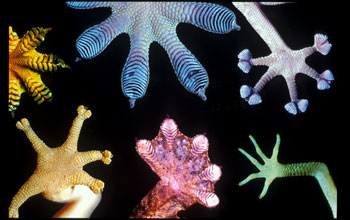Multimedia Gallery
Gecko Feet
Gecko feet--each with a different toe pad structure. It is well known that the only force causing two hydrophobic surfaces to adhere in air is van der Waals force (in chemistry, van der Waals force refers to the relatively weak attraction between neutral atoms and molecules arising from polarization induced in each particle by the presence of other particles). Thus, the strong adhesion of ultrahydrophobic gecko setae to highly hydrophobic GaAs demonstrates that van der Waals forces are sufficient for gecko adhesion, and that other forces, such as those of capillary bridges, are not required.
Since van der Waals forces occur between any two surfaces that are sufficiently close, this discovery paved the way for the design and fabrication of synthetic dry adhesives, inspired by geckos. (Date of Image: 2002) [One of two related images. See Next Image.]
More about this Species
Assistant professor of biology Kellar Autumn and a team of biologists and engineers have cracked the molecular secrets of the gecko's unsurpassed sticking power, opening the door for engineers to fabricate prototypes of synthetic gecko adhesive. Working at Lewis & Clark College, the University of California at Berkeley, the University of California at Santa Barbara, and Stanford University, the interdisciplinary team confirmed speculation that the gecko's amazing climbing ability depends on weak molecular attractive forces called van der Waals forces. They also discovered that the gecko's adhesive depends on geometry, not surface chemistry. In other words, the size and shape of the tips of gecko foot hairs--not what they are made of--determine the gecko's stickiness. These results inspired the fabrication of synthetic foot-hair tips that adhere, and was the cover story in the Proceedings of the National Academy of Sciences, USA 99(19): 12252-12256. To learn more about this and other gecko research performed in the lab of professor Autumn, visit his home page.
[Image from Cover of Proceedings of the National Academy of Sciences, Autumn, K., Sitti, M., Peattie, A., Hansen, W., Sponberg, S., Liang, Y.A., Kenny, T., Fearing, R., Israelachvili, J. and Full, R.J. (2002). Evidence for van der Waals adhesion in gecko setae. Proc. Natl. Acad. Sci. USA 99, 12252-12256.]
Credit: Image courtesy professor Kellar Autumn, from Autumn, K., et al. 2002. Evidence for van der Waals adhesion in gecko setae. Proc. Natl. Acad. Sci. USA 99, 12252-12256.
See other images like this on your iPhone or iPad download NSF Science Zone on the Apple App Store.
Special Restrictions: Permission to use image is granted for noncommercial use only, and must be accompanied by the following citation of source publication: Autumn, K., et al. 2002. Evidence for van der Waals adhesion in gecko setae. Proc. Natl. Acad. Sci. USA 99, 12252-12256.
Images and other media in the National Science Foundation Multimedia Gallery are available for use in print and electronic material by NSF employees, members of the media, university staff, teachers and the general public. All media in the gallery are intended for personal, educational and nonprofit/non-commercial use only.
Images credited to the National Science Foundation, a federal agency, are in the public domain. The images were created by employees of the United States Government as part of their official duties or prepared by contractors as "works for hire" for NSF. You may freely use NSF-credited images and, at your discretion, credit NSF with a "Courtesy: National Science Foundation" notation.
Additional information about general usage can be found in Conditions.
Also Available:
Download the high-resolution JPG version of the image. (1.7 MB)
Use your mouse to right-click (Mac users may need to Ctrl-click) the link above and choose the option that will save the file or target to your computer.

